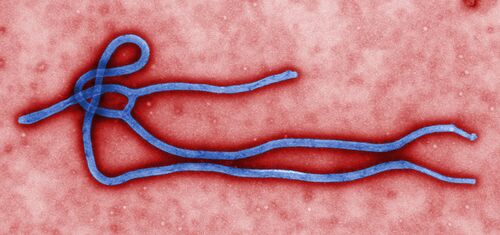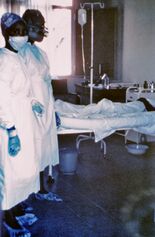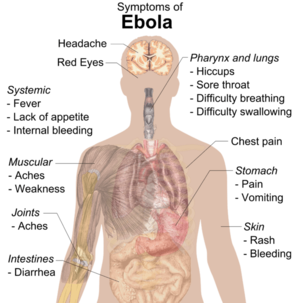Infection of ebola virus: Difference between revisions
| (39 intermediate revisions by the same user not shown) | |||
| Line 1: | Line 1: | ||
==Introduction== | ==Introduction== | ||
[[Image:Ebola_Virus.jpeg|thumb|500px|right|Figure 1. Diagram of the Ebola Virus captured via electron microscopy. The image has been colorized to highlight the particle's filamentous branching structure. <ref>“Ebola (Ebola Virus Disease).” Centers for Disease Control and Prevention. Centers for Disease Control and Prevention, September 26, 2022. https://www.cdc.gov/vhf/ebola/index.html.</ref>]] | |||
The Ebola virus is an RNA virus that | The Ebola virus (Figure 1) is an RNA virus that affects the way the blood clots. It is caused by a virus belonging to the Filoviridae family, genus Ebolavirus. Ebola is regarded as a hemorrhagic fever virus because the clotting deficiencies lead to internal bleeding due to blood leaking from small blood vessels in your body. The virus infects numerous essential cells in the immune system, such as dendritic cells, macrophages, monocytes and many more. Upon infection, it causes system-wide inflammation and fever. As a result of inadequate blood clotting, organ failure occurs which eventually leads to one's death. | ||
Ebola was first discovered in Africa in 1976 near the Ebola River in the Democratic Republic of Congo. The virus's origin is unknown, but it is believed to have begun in animals and eventually spread to humans. The virus as we know it today predominantly affects primates, specifically humans. The period 2014-2016 is regarded as an epidemic due to the Ebola outbreak in West Africa. At the end of the epidemic, it was recorded that a total of 28,600 people were infected and 11,325 people died from Ebola<ref>Centers for Disease Control and Prevention. (2019, March 8). 2014-2016 ebola outbreak in West Africa. Centres for Disease Control and Prevention. Retrieved December 1, 2022, from https://www.cdc.gov/vhf/ebola/history/2014-2016-outbreak/index.html </ref> | |||
. The virus had a fatality rate of about 40%. The cases were mainly concentrated in West Africa and would spread through the bodily fluids of a person who died from or was contaminated with the virus. | |||
Currently, there are treatments in place that can inhibit the virus from entering a person's body. If infected, however, high intakes of electrolytes and medications that support blood pressure, diarrhoea and other symptoms related to Ebola are recommended. | |||
==Transmission== | |||
Ebola Virus can be transmitted in a number of ways, the most common being through the transmission of bodily fluids, sexual contact or infection by animals. | |||
Transmission through bodily fluids is the virus's most expansive means of transmission. These include but are not limited to an infected person’s blood, urine, feces, vomit, sweat, saliva or amniotic fluid. Any contact with a person who has recently died from the Ebola virus could result in the transmission of the virus. | |||
The virus can also spread through sexual transmission. A study has shown that the virus is able to survive in seminal fluid for up to 70 days<ref>“What We Know about Transmission of the Ebola Virus among Humans.” World Health Organization. World Health Organization. Accessed November 26, 2022. https://www.who.int/news/item/06-10-2014-what-we-know-about-transmission-of-the-ebola-virus-among-humans. </ref> | |||
< | . It can remain in certain fluids for prolonged times even if the infected person shows no symptoms<ref>“Transmission.” Centers for Disease Control and Prevention. Centers for Disease Control and Prevention, January 14, 2021. https://www.cdc.gov/vhf/ebola/transmission/index.html. </ref> | ||
. | |||
Lastly, the virus can be transmitted through infected animals, such as bats or other primates (monkeys/apes). As well as through contact with objects that contain bodily fluids from an infected person. | |||
[[Image:Ebola 1976.jpg|thumb|left|155px|Figure 2. Nurses in the room of a person infected with the Ebola virus in 1976. The picture was taken in the Ngaliema Hospital in Kinshasa, the patient in the image later died.<ref>“Part Two: A Virologist's Tale of Africa's First Encounter with Ebola.” Science. Accessed December 1, 2022. https://www.science.org/content/article/part-two-virologists-tale-africas-first-encounter-ebola.</ref>]] | |||
==Infection== | |||
When infected by the Ebola virus (EBOV), it usually takes 3 days after infection for the virus to be detected. At that point, one would typically be displaying signs of infection. EBOV enters the body through mucosal surfaces, abrasions, opening in the skin or direct parental transmission. The virus can attack numerous organs upon infection using different attachment mechanisms for every cell type<ref>Falasca, L, Agrati, C, Petrosillo, N, Caro, A D., Capobianchi, M R., Ippolito, G, and M Piacentini. "Molecular mechanisms of Ebola virus pathogenesis: focus on cell death." Cell Death and Differentiation 22, no. 8 (2015): 1250-1259. Accessed November 25, 2022. https://doi.org/10.1038/cdd.2015.67.</ref> | |||
. This means that EBOV is able to attach to then subsequently invade numerous receptors along with their cells. So far there is no specificity in regard to cell attachment, lymphocytes are the only recorded cells to prohibit virus attachment<ref>Servick, Kelly. “What Does Ebola Actually Do?” Science, August 13, 2014. https://www.science.org/content/article/what-does-ebola-actually-do. </ref>. | |||
Uptake of the virus is typically done through a process called micropinocytosis. Micropinocytosis is a process in which macromolecules are engulfed into the cell membrane via small vesicles on the surface of the cell. The Ebola virus contains glycoprotein spikes that bind to host cells and mediate fusion between the viral envelope and the host cell membrane, allowing the virus to release its contents into the host cell’s membrane. But to allow the fusion of the virus to the host cell, the glycoproteins spikes need to undergo a conformational change. This is when environmental factors alter the shape of a macromolecule. | |||
<ref | It was discovered that endosomal cysteine proteases, cathepsin B and cathepsin L are responsible for those changes<ref>Jain, Sahil, Martynova, Ekaterina, Rizvanov, Albert, Khaiboullina, Svetlana, and Manoj Baranwal. "Structural and Functional Aspects of Ebola Virus Proteins." Pathogens 10, no. 10 (2021). Accessed November 25, 2022. https://doi.org/10.3390/pathogens10101330.</ref> | ||
. | |||
EBOV’s glycoprotein (GP) consists of 2 subunits, GP1 and GP2<ref>Kawaoka, Yoshihiro, Author AffiliationsFrom the International Research Center for Infectious Diseases and the Division of Virology, Y. Feng and F. Wang, T. L. Cowger and Others, and T. R. Mikuls. “How Ebola Virus Infects Cells: Nejm.” New England Journal of Medicine, November 17, 2022. https://www.nejm.org/doi/full/10.1056/NEJMcibr051754. </ref>. GP1 undergoes proteolysis by cathepsin B and cathepsin L; which then leads to viral interaction with the host receptor cholesterol transporter Niemann-Pick C1 (NPC1), which is critical for viral entry. GP2 is responsible for mediating the fusion of the viral and cellular membranes | |||
. This leads to the release of the viral nucleocapsid into the cytoplasm of the now-infected cell where transcription and replication of the viral genome occur. | |||
During transcription, antigenomes are used as a template for the transcription of progeny genomes. When all the parts of the new viruses are fully assembled, the new viruses “bud “ from the cell using its membrane to create a capsule for secure travel to other cells. | |||
==Symptoms== | |||
[[Image:Symptoms_of_ebola.png|thumb|300px|right| Figure 3. View of all the signs and symptoms related with the Ebola Virus <ref>Aryal, Sagar. “Signs and Symptoms of Ebola Virus Disease.” Microbiology Info.com, August 10, 2022. https://microbiologyinfo.com/signs-and-symptoms-of-ebola-virus-disease/.</ref> ]] | |||
Some of the most prevalent symptoms of Ebola include: | |||
Haemorrhaging, gastrointestinal symptoms (abdominal pain, diarrhoea, vomiting), fatigue, fever and bodily aches | |||
Though all these symptoms are serious, haemorrhaging is the most deadly. This virus is so deadly because of uncontrollable blood loss and fever. As the disease continues to progress within the body, it will hinder the blood's ability to clot. Leading to the passing of blood through openings in the body, such as one’s eyes, ears and nose. Blood could also be lost through vomiting and diarrhoea. As this continues the body’s organs will eventually fail, resulting in the individual's death. | |||
Figure 3, shows all the symptoms that are currently related to the virus. | |||
==Conclusion== | ==Conclusion== | ||
Belonging to the Filoviridae family, genus Ebolavirus, the Ebola virus is a deadly virus that is able to infect the body through numerous mechanisms. It is responsible for the 2014-2016 epidemic that affected numerous countries in West Africa and left many casualties. Because one needs to be in direct contact with an infected individual to catch the virus, its spread can be maintained better than an airborne virus. For the most part, the virus is under control and numerous treatments have been created but occasionally small outbreaks do occur. | |||
==References== | ==References== | ||
<br>Edited by [Durwynn Jno Baptiste], student of [mailto:slonczewski@kenyon.edu Joan Slonczewski] for [http://biology.kenyon.edu/courses/biol116/biol116_Fall_2013.html BIOL 116 Information in Living Systems], 2022, [http://www.kenyon.edu/index.xml Kenyon College]. | <br>Edited by [Durwynn Jno Baptiste], student of [mailto:slonczewski@kenyon.edu Joan Slonczewski] for [http://biology.kenyon.edu/courses/biol116/biol116_Fall_2013.html BIOL 116 Information in Living Systems], 2022, [http://www.kenyon.edu/index.xml Kenyon College]. | ||
<!--Do not edit or remove this line-->[[Category:Pages edited by students of Joan Slonczewski at Kenyon College]] | <!--Do not edit or remove this line-->[[Category:Pages edited by students of Joan Slonczewski at Kenyon College]] | ||
Latest revision as of 13:46, 7 December 2022
Introduction

The Ebola virus (Figure 1) is an RNA virus that affects the way the blood clots. It is caused by a virus belonging to the Filoviridae family, genus Ebolavirus. Ebola is regarded as a hemorrhagic fever virus because the clotting deficiencies lead to internal bleeding due to blood leaking from small blood vessels in your body. The virus infects numerous essential cells in the immune system, such as dendritic cells, macrophages, monocytes and many more. Upon infection, it causes system-wide inflammation and fever. As a result of inadequate blood clotting, organ failure occurs which eventually leads to one's death.
Ebola was first discovered in Africa in 1976 near the Ebola River in the Democratic Republic of Congo. The virus's origin is unknown, but it is believed to have begun in animals and eventually spread to humans. The virus as we know it today predominantly affects primates, specifically humans. The period 2014-2016 is regarded as an epidemic due to the Ebola outbreak in West Africa. At the end of the epidemic, it was recorded that a total of 28,600 people were infected and 11,325 people died from Ebola[2] . The virus had a fatality rate of about 40%. The cases were mainly concentrated in West Africa and would spread through the bodily fluids of a person who died from or was contaminated with the virus.
Currently, there are treatments in place that can inhibit the virus from entering a person's body. If infected, however, high intakes of electrolytes and medications that support blood pressure, diarrhoea and other symptoms related to Ebola are recommended.
Transmission
Ebola Virus can be transmitted in a number of ways, the most common being through the transmission of bodily fluids, sexual contact or infection by animals.
Transmission through bodily fluids is the virus's most expansive means of transmission. These include but are not limited to an infected person’s blood, urine, feces, vomit, sweat, saliva or amniotic fluid. Any contact with a person who has recently died from the Ebola virus could result in the transmission of the virus.
The virus can also spread through sexual transmission. A study has shown that the virus is able to survive in seminal fluid for up to 70 days[3] . It can remain in certain fluids for prolonged times even if the infected person shows no symptoms[4] .
Lastly, the virus can be transmitted through infected animals, such as bats or other primates (monkeys/apes). As well as through contact with objects that contain bodily fluids from an infected person.

Infection
When infected by the Ebola virus (EBOV), it usually takes 3 days after infection for the virus to be detected. At that point, one would typically be displaying signs of infection. EBOV enters the body through mucosal surfaces, abrasions, opening in the skin or direct parental transmission. The virus can attack numerous organs upon infection using different attachment mechanisms for every cell type[6] . This means that EBOV is able to attach to then subsequently invade numerous receptors along with their cells. So far there is no specificity in regard to cell attachment, lymphocytes are the only recorded cells to prohibit virus attachment[7]. Uptake of the virus is typically done through a process called micropinocytosis. Micropinocytosis is a process in which macromolecules are engulfed into the cell membrane via small vesicles on the surface of the cell. The Ebola virus contains glycoprotein spikes that bind to host cells and mediate fusion between the viral envelope and the host cell membrane, allowing the virus to release its contents into the host cell’s membrane. But to allow the fusion of the virus to the host cell, the glycoproteins spikes need to undergo a conformational change. This is when environmental factors alter the shape of a macromolecule.
It was discovered that endosomal cysteine proteases, cathepsin B and cathepsin L are responsible for those changes[8] . EBOV’s glycoprotein (GP) consists of 2 subunits, GP1 and GP2[9]. GP1 undergoes proteolysis by cathepsin B and cathepsin L; which then leads to viral interaction with the host receptor cholesterol transporter Niemann-Pick C1 (NPC1), which is critical for viral entry. GP2 is responsible for mediating the fusion of the viral and cellular membranes . This leads to the release of the viral nucleocapsid into the cytoplasm of the now-infected cell where transcription and replication of the viral genome occur. During transcription, antigenomes are used as a template for the transcription of progeny genomes. When all the parts of the new viruses are fully assembled, the new viruses “bud “ from the cell using its membrane to create a capsule for secure travel to other cells.
Symptoms

Some of the most prevalent symptoms of Ebola include:
Haemorrhaging, gastrointestinal symptoms (abdominal pain, diarrhoea, vomiting), fatigue, fever and bodily aches
Though all these symptoms are serious, haemorrhaging is the most deadly. This virus is so deadly because of uncontrollable blood loss and fever. As the disease continues to progress within the body, it will hinder the blood's ability to clot. Leading to the passing of blood through openings in the body, such as one’s eyes, ears and nose. Blood could also be lost through vomiting and diarrhoea. As this continues the body’s organs will eventually fail, resulting in the individual's death.
Figure 3, shows all the symptoms that are currently related to the virus.
Conclusion
Belonging to the Filoviridae family, genus Ebolavirus, the Ebola virus is a deadly virus that is able to infect the body through numerous mechanisms. It is responsible for the 2014-2016 epidemic that affected numerous countries in West Africa and left many casualties. Because one needs to be in direct contact with an infected individual to catch the virus, its spread can be maintained better than an airborne virus. For the most part, the virus is under control and numerous treatments have been created but occasionally small outbreaks do occur.
References
Edited by [Durwynn Jno Baptiste], student of Joan Slonczewski for BIOL 116 Information in Living Systems, 2022, Kenyon College.
- ↑ “Ebola (Ebola Virus Disease).” Centers for Disease Control and Prevention. Centers for Disease Control and Prevention, September 26, 2022. https://www.cdc.gov/vhf/ebola/index.html.
- ↑ Centers for Disease Control and Prevention. (2019, March 8). 2014-2016 ebola outbreak in West Africa. Centres for Disease Control and Prevention. Retrieved December 1, 2022, from https://www.cdc.gov/vhf/ebola/history/2014-2016-outbreak/index.html
- ↑ “What We Know about Transmission of the Ebola Virus among Humans.” World Health Organization. World Health Organization. Accessed November 26, 2022. https://www.who.int/news/item/06-10-2014-what-we-know-about-transmission-of-the-ebola-virus-among-humans.
- ↑ “Transmission.” Centers for Disease Control and Prevention. Centers for Disease Control and Prevention, January 14, 2021. https://www.cdc.gov/vhf/ebola/transmission/index.html.
- ↑ “Part Two: A Virologist's Tale of Africa's First Encounter with Ebola.” Science. Accessed December 1, 2022. https://www.science.org/content/article/part-two-virologists-tale-africas-first-encounter-ebola.
- ↑ Falasca, L, Agrati, C, Petrosillo, N, Caro, A D., Capobianchi, M R., Ippolito, G, and M Piacentini. "Molecular mechanisms of Ebola virus pathogenesis: focus on cell death." Cell Death and Differentiation 22, no. 8 (2015): 1250-1259. Accessed November 25, 2022. https://doi.org/10.1038/cdd.2015.67.
- ↑ Servick, Kelly. “What Does Ebola Actually Do?” Science, August 13, 2014. https://www.science.org/content/article/what-does-ebola-actually-do.
- ↑ Jain, Sahil, Martynova, Ekaterina, Rizvanov, Albert, Khaiboullina, Svetlana, and Manoj Baranwal. "Structural and Functional Aspects of Ebola Virus Proteins." Pathogens 10, no. 10 (2021). Accessed November 25, 2022. https://doi.org/10.3390/pathogens10101330.
- ↑ Kawaoka, Yoshihiro, Author AffiliationsFrom the International Research Center for Infectious Diseases and the Division of Virology, Y. Feng and F. Wang, T. L. Cowger and Others, and T. R. Mikuls. “How Ebola Virus Infects Cells: Nejm.” New England Journal of Medicine, November 17, 2022. https://www.nejm.org/doi/full/10.1056/NEJMcibr051754.
- ↑ Aryal, Sagar. “Signs and Symptoms of Ebola Virus Disease.” Microbiology Info.com, August 10, 2022. https://microbiologyinfo.com/signs-and-symptoms-of-ebola-virus-disease/.
